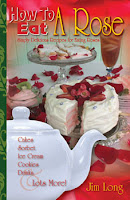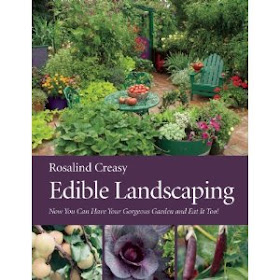I'm excited to share with you a garden I was privileged to visit a couple of weeks ago. Rosalind Creasy has been gardening and writing about gardening for decades. Back when no one had heard about local foods and heirloom vegetables, much less edible landscaping, Ros was plowing her garden and planting the seeds that are now part of a nationwide movement. Her first book,
The Complete Book of Edible Landscaping, was published by the Sierra Club in 1982. To get an idea of what she started with in the late 1970s, here's a view of her front yard:
 |
| Just an ordinary house on a small lot. The book, and the garden, had not yet been created. |
Roalind Creasy is a landscape architect with a great eye for design, so it is no wonder the simple lot went from that, to what you see below. Instead of filling the newly cleared spaces with more green bushy things
(the kind of plants I claim don't pay their rent, meaning, don't justify the space they take up in the landscape because they give nothing back) she planted edible plants everywhere. Here's almost the same view just 2 weeks ago:
 |
| Rosalind Creasy meets ust curbside in her edible landscape paradise. |
Here (above) is that pesky dividing strip between houses, neighbors driveway on the left, Ros' driveway on the right. What's there besides the little hedge that acts as a curb? A few flowers, but if you look close, there are 3 very large eggplants and a planter filled with sweet peppers of several varieties. Just think, most people make this spot lawn that has to be mowed.
 |
| Still curbside, the bed is filled with herbs, vegetables and flowers. |
I took 2 steps to the right after taking the curbside photo, still at Ros' driveway. Remember that photo in the beginning of the blank looking front yard? The street shows in the lower right corner, the driveway in the lower left of the photo, and everything else, between, is edibles. Great, arching rosemaries, potted figs, tomatoes, oregano, nasturtiums. Keep in mind, I'm still in the street, I haven't even stepped into the garden yet!
 |
| Standing at the front door, looking toward the street. |
If you could look to the left, near the blue-green lattice fence in the left of the photo, you would discover the chicken pens. School children make a bee-line through the front of the garden almost every day to check on and see the chickens.
 |
| One of two chicken pens in the back of the photo. This is still curbside, too. |
 |
| We're still in Ros' front yard. Several kinds of peppers and squash are in this bed, plus some herbs. |
I didn't count how many raised beds and planters there were in the front garden, but many. Ros has blackberries, tomatoes, squash, eggplant, herbs, roses (remember my
How to Eat a Rose book? Roses are edibles, too) and so many more vegetables and fruit I don't even remember them all. You could feed a family from the front garden and that doesn't even begin to describe the back garden!
Rosalind Creasy's first book,
The Complete Book of Edible Landscaping can still be found on Amazon. Her second book,
Edible Landscaping, newly released is also available on Amazon as well as through your local bookstore. It includes the basics for how turn your front (and back) yard into something other than grass and bushes. Learn about growing vegetables and herbs in containers, learn about organic pest controls, composting and a whole lot more. This is a large, hefty book, and it's overflowing with information from someone who knows gardening.
When I asked Ros if I could see her compost area, it didn't surprise me one bit to find a wonderful, working, well tended compost system, landscaped, of course! The chicken litter, garden debris, kitchen vegetable scraps and other organic compostables, all go into the compost and get recycled as new, rich soil into the garden beds.
 |
| Garden waste in, organic soil out and no fertilizer required to grow a garden. |
And one more growing area, in the photo below, still in the front garden between the street and the house. The chicken pens are in the upper right of the photo, near the street.
 |
| Click to enlarge. |





































